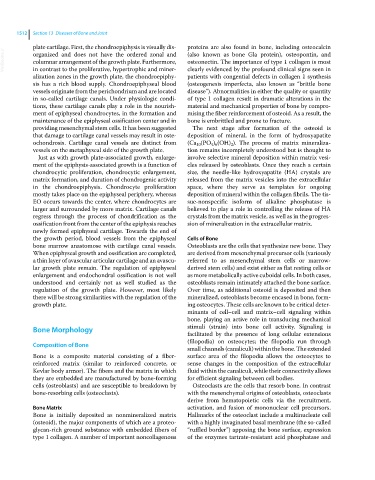Page 1574 - Clinical Small Animal Internal Medicine
P. 1574
1512 Section 13 Diseases of Bone and Joint
plate cartilage. First, the chondroepiphysis is visually dis- proteins are also found in bone, including osteocalcin
VetBooks.ir organized and does not have the ordered zonal and (also known as bone Gla protein), osteopontin, and
osteonectin. The importance of type 1 collagen is most
columnar arrangement of the growth plate. Furthermore,
in contrast to the proliferative, hypertrophic and miner-
patients with congential defects in collagen 1 synthesis
alization zones in the growth plate, the chondroepiphy- clearly evidenced by the profound clinical signs seen in
sis has a rich blood supply. Chondroepiphyseal blood (osteogenesis imperfecta, also known as “brittle bone
vessels originate from the perichondrium and are located disease”). Abnormalities in either the quality or quantity
in so‐called cartilage canals. Under physiologic condi- of type 1 collagen result in dramatic alterations in the
tions, these cartilage canals play a role in the nourish- material and mechanical properties of bone by compro-
ment of epiphyseal chondrocytes, in the formation and mising the fiber reinforcement of osteoid. As a result, the
maintenance of the epiphyseal ossification center and in bone is embrittled and prone to fracture.
providing mesenchymal stem cells. It has been suggested The next stage after formation of the osteoid is
that damage to cartilage canal vessels may result in oste- deposition of mineral, in the form of hydroxyapatite
ochondrosis. Cartilage canal vessels are distinct from (Ca 10 (PO 4 ) 6 (OH) 2 ). The process of matrix mineraliza-
vessels on the metaphyseal side of the growth plate. tion remains incompletely understood but is thought to
Just as with growth plate‐associated growth, enlarge- involve selective mineral deposition within matrix vesi-
ment of the epiphysis‐associated growth is a function of cles released by osteoblasts. Once they reach a certain
chondrocytic proliferation, chondrocytic enlargement, size, the needle‐like hydroxyapatite (HA) crystals are
matrix formation, and duration of chondrogenic activity released from the matrix vesicles into the extracellular
in the chondroepiphysis. Chondrocyte proliferation space, where they serve as templates for ongoing
mostly takes place on the epiphyseal periphery, whereas deposition of mineral within the collagen fibrils. The tis-
EO occurs towards the center, where chondrocytes are sue‐nonspecific isoform of alkaline phosphatase is
larger and surrounded by more matrix. Cartilage canals believed to play a role in controlling the release of HA
regress through the process of chondrification as the crystals from the matrix vesicle, as well as in the progres-
ossification front from the center of the epiphysis reaches sion of mineralization in the extracellular matrix.
newly formed epiphyseal cartilage. Towards the end of
the growth period, blood vessels from the epiphyseal Cells of Bone
bone marrow anastomose with cartilage canal vessels. Osteoblasts are the cells that synthesize new bone. They
When epiphyseal growth and ossification are completed, are derived from mesenchymal precursor cells (variously
a thin layer of avascular articular cartilage and an avascu- referred to as mesenchymal stem cells or marrow‐
lar growth plate remain. The regulation of epiphyseal derived stem cells) and exist either as flat resting cells or
enlargement and endochondral ossification is not well as more metabolically active cuboidal cells. In both cases,
understood and certainly not as well studied as the osteoblasts remain intimately attached the bone surface.
regulation of the growth plate. However, most likely Over time, as additional osteoid is deposited and then
there will be strong similarities with the regulation of the mineralized, osteoblasts become encased in bone, form-
growth plate. ing osteocytes. These cells are known to be critical deter-
minants of cell–cell and matrix–cell signaling within
bone, playing an active role in transducing mechanical
Bone Morphology stimuli (strain) into bone cell activity. Signaling is
facilitated by the presence of long cellular extensions
(filopodia) on osteocytes; the filopodia run through
Composition of Bone
small channels (canaliculi) within the bone. The extended
Bone is a composite material consisting of a fiber‐ surface area of the filopodia allows the osteocytes to
reinforced matrix (similar to reinforced concrete, or sense changes in the composition of the extracellular
Kevlar body armor). The fibers and the matrix in which fluid within the canaliculi, while their connectivity allows
they are embedded are manufactured by bone‐forming for efficient signaling between cell bodies.
cells (osteoblasts) and are susceptible to breakdown by Osteoclasts are the cells that resorb bone. In contrast
bone‐resorbing cells (osteoclasts). with the mesenchymal origins of osteoblasts, osteoclasts
derive from hematopoietic cells via the recruitment,
Bone Matrix activation, and fusion of mononuclear cell precursors.
Bone is initially deposited as nonmineralized matrix Hallmarks of the osteoclast include a multinucleate cell
(osteoid), the major components of which are a proteo- with a highly invaginated basal membrane (the so‐called
glycan‐rich ground substance with embedded fibers of “ruffled border”) apposing the bone surface, expression
type 1 collagen. A number of important noncollagenous of the enzymes tartrate‐resistant acid phosphatase and

